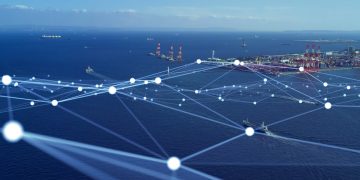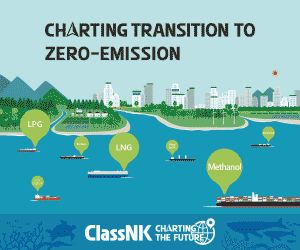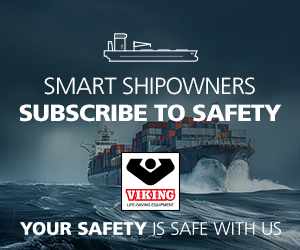NTSB published its accident report on the collision between the private Yacht Utopia IV and the tanker Tropic Breeze, on December 23, 2021, Northeast Providence Channel, 20 miles northwest of Nassau, Bahamas.
The incident
On December 23, 2021, at 1800, the Tropic Breeze departed Clifton Pier on New Providence Island at a speed of 5 knots en route to Great Stirrup Cay—a voyage north-northwest that was estimated to take 12 hours. The vessel was loaded with a cargo of 100,000 gallons of high-sulfur marine gas oil (MGO), 22,000 gallons of ultra-low sulfur MGO, 20,000 gallons of gasoline, and 8,500 gallons of liquid petroleum gas. The vessel also carried 6,000 gallons of ultra-low sulfur MGO as bunkers (vessel fuel). All but two cargo tanks were pressed up (full), and there was no ballast on board. The vessel’s loaded draft was 7.5 feet (hull depth of 9.8 feet). The vessel had a crew of seven, and according to the master, “everything on the bridge was working.”
At 2030, the Utopia IV weighed anchor offshore of Albany (on New Providence Island) and got underway toward Bimini Island (about 160 miles away) at a speed of about 20 knots. The captain’s planned route took the vessel around the west side of New Providence Island and north of the Berry Islands. The yacht carried 7 passengers in addition to 12 crewmembers. The captain conned the vessel while the bosun navigated and kept a bridge log. The bosun stated that the weather was clear, but bow spray made it more difficult to see outside from inside the wheelhouse and required intermittent use of bridge window wipers. According to the bosun, the Utopia IV’s plumb bow allowed more water to collect on deck and the windshield. The display for one of the vessel’s radars (S-band) was inoperative; the other radar (X-band) was set to a 3-mile scale.
The Utopia IV had a forward masthead light mounted on a telescoping mast that could be retracted into the deck when not in use. According to the captain, a mechanical issue prevented the mast from being completely extended during the casualty voyage.
About 2100, the captain stated that he left the wheelhouse with a radio to check on the passengers. He returned to the wheelhouse before departing again at 2148 to check on the passengers. He stated that he saw no visual, automatic identification system (AIS), or radar targets before departing. The captain told investigators he expected the bosun to maneuver as necessary for traffic; however, the bosun stated his understanding was that he first had to radio the captain to receive permission to maneuver the vessel. The bosun told investigators that while he was alone in the wheelhouse after the captain’s departure, he did not see any visual, radar, or AIS targets.
On board the Tropic Breeze, the master and an able seafarer (AB) were on watch on the bridge. According to the crew, the Tropic Breeze’s AIS had a power issue, worked only intermittently, and was scheduled to be repaired as soon as COVID precautions allowed a technician to travel to the vessel. The vessel also had two radars: the master stated that one was off at the time, and the other was set to a 3-mile scale. The master had the radar set to alarm for targets within 2 miles. The crew stated that the mast atop the bridge blocked the radar sweep aft, so the radar display showed a shadow area directly astern. (After the casualty, the master stated that he did not see the Utopia IV on the radar.) The master had set up the autopilot earlier in the evening, and according to the AB, there were no course changes during his watch.
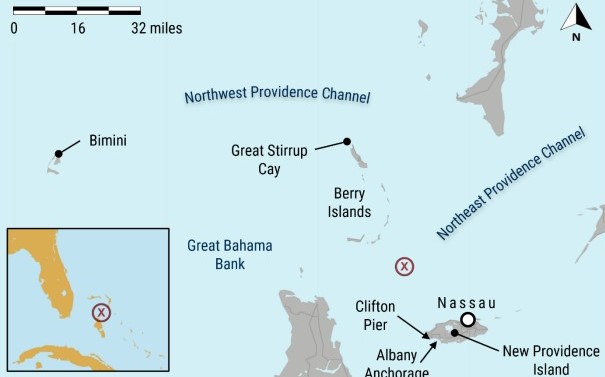
Just before 2200, the bosun on the Utopia IV turned his attention to recording the hourly log entries and navigation fix, leaving his back turned to the forward windows (the captain had not yet returned to the wheelhouse, having left at 2148). About the same time, the Tropic Breeze’s master started toward his cabin, immediately aft of the bridge, to use the restroom.
At 2200:48, a closed-circuit television (CCTV) camera in the Utopia IV’s galley captured equipment and crew suddenly propelled forward as the bow of the Utopia IV (traveling at about 20 knots) struck the transom of the Tropic Breeze (traveling at about 5 knots) from directly astern, slightly to port of the tank vessel’s centerline. Several of the yacht’s crew were thrown to the deck or into bulkheads as Utopia IV struck the tank vessel at a relative speed of about 15 knots; three crewmembers sustained minor injuries. The Utopia IV’s captain was in the main dining area and was thrown into the “forward bulkhead and door frame.”
The Utopia IV’s chief stewardess told investigators she saw the Tropic Breeze’s navigation lights illuminated post-collision. According to the Utopia IV’s crew, the Utopia IV’s lights were all on.
The Tropic Breeze’s chief engineer investigated the tanker’s damage. He found the engine room was flooding rapidly. He went to the bridge and reported the flooding to the master; he stated that he did not see the source of flooding, but the engine had stopped once it was submerged. About 2215, 15 minutes after the collision, the captain made a VHF distress call and decided to abandon the vessel because he did not believe the Tropic Breeze could survive a flooded engine room. The crew launched the rescue boat and a liferaft (the rafts were stowed aft of the bridge on the same deck). One or two crewmembers boarded the rescue boat, and the remainder of the crew boarded the liferaft.
The Utopia IV’s chief engineer restarted the yacht’s engines, which had shut down after the collision. The chief mate, who had come to the wheelhouse, made a distress call by VHF radio. The Utopia IV was maneuvered to recover the Tropic Breeze’s crew, and the stern swim platform was lowered to allow them to board; however, sea swells and the height of the platform prevented them from boarding.
The yacht Amara heard three VHF distress calls from the Utopia IV (the crew on watch did not hear any from the Tropic Breeze), and the Royal Bahamian Defense Forces (which fulfill a role similar to the US Coast Guard) also received the distress calls. The Amara arrived on scene and dispatched the vessel’s 38-foot-long tender (which the Amara had been towing) with a crew of three, who then recovered all of the tanker’s crew from the liferaft and rescue boat. The crewmembers on the tender and the Amara’s captain concurred it was not safe to get Tropic Breeze’s crew aboard either the Amara or the Utopia IV due to the sea state, so they were taken ashore to Lyford Cay Marina in Nassau via the tender, arriving about 0240.
The Tropic Breeze continued to flood, and according to the master, the vessel sank about 25 minutes after the collision. An alert from the vessel’s Global Navigation Satellite System (GNSS)-enabled emergency position indicating radio beacon (EPIRB) was received by the Coast Guard’s Rescue Coordination Center Miami at 2226, via the French Mission Control Center and medium Earth orbit search and rescue (MEOSAR)-enabled satellites.
Analysis
The Utopia IV and Tropic Breeze were both equipped with radar—regulations require systematic observations of radar targets to determine risk of collision—set to a 3-mile scale. With the Utopia IV approaching the Tropic Breeze at a relative speed of 15 knots, a target would close 3 miles in just 12 minutes. However, none of the watchstanders on the Utopia IV (captain and bosun) or Tropic Breeze (master and AB) reported seeing the other vessel on radar; therefore, it is likely none of them had looked at the radar in the 12 minutes before the collision (although the Tropic Breeze crew stated there was a radar shadow aft, it is likely that the approach of the yacht would have been detected on radar). Additionally, there was no evidence that they used radar for long-range scanning. Therefore, neither crew used their vessel’s radar effectively.
The Tropic Breeze was equipped with an AIS, which consists of a VHF transponder that transmits a vessel’s identity, course, speed, size, and destination. The information is available to nearby vessels on their AIS display unit, radar, and/or electronic chart display and information system, which in turn will calculate and display a target’s closest point of approach (CPA) and time to CPA. However, the Tropic Breeze’s AIS was inoperative due to a power issue: investigators queried databases and found the unit had not transmitted a position in 11 months. (There were repair parts on board awaiting a technician.) Had the unit been functioning, it is likely that the Utopia IV could have detected the Tropic Breeze before the collision. Likewise, with the unit inoperative, the Tropic Breeze could not display the Utopia IV’s AIS signal and identify the yacht’s position relative to the tank vessel.
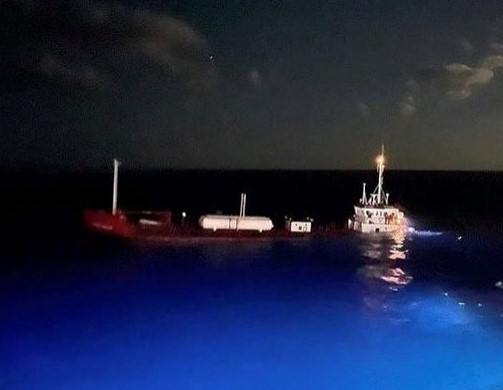
As the Utopia IV approached the Tropic Breeze from nearly directly astern, the yacht (as the overtaking vessel) was required by 72 COLREGS to give way to the tank vessel. However, because the watchstanders on the Utopia IV were not maintaining a proper lookout using all available means, they did not identify the risk of collision. Although the Utopia IV bore responsibility as the overtaking vessel to maneuver away from the tank vessel, once the yacht’s intentions were unclear and a close-quarters situation had developed, the tank vessel should have taken action. However, the watchstanders on the Tropic Breeze did not detect the Utopia IV approaching. If they had seen the yacht, they likely would have signaled the potential danger in some way, whether by radio communication, whistle, or other means. Therefore, the Tropic Breeze’s watchstanders were also not maintaining a proper lookout. Had either kept a proper lookout, they likely would have detected each other and could have taken action to avoid the collision.
Conclusions
The National Transportation Safety Board determines that the probable cause of the collision between the yacht Utopia IV and the tank vessel Tropic Breeze was the Utopia IV’s wheelhouse crew not maintaining a proper lookout and therefore not identifying the tank vessel they were overtaking. Contributing was the Tropic Breeze’s bridge team also not maintaining a proper lookout.
Lessons learned
A proper lookout by suitably trained crewmembers is required by the Convention on the International Regulations for Preventing Collisions at Sea, 1972 and is essential in determining the risk of collision. The effective use of all available resources by a bridge team, including visual scanning, radars, electronic charts, and an automatic identification system, increases collective situational awareness and contributes to a safe navigation watch. Operators and crews should ensure that vessel bridge teams are staffed with certificated/credentialed mariners who are familiar with all bridge navigation equipment and able to independently take immediate action.



















